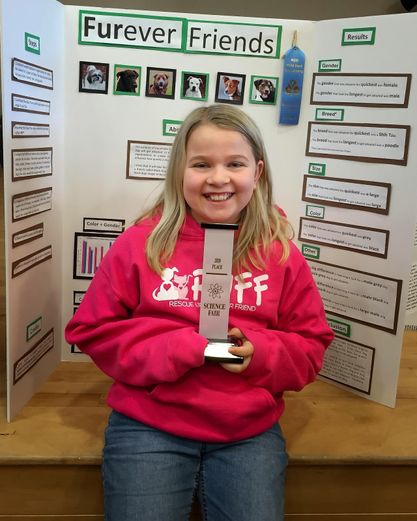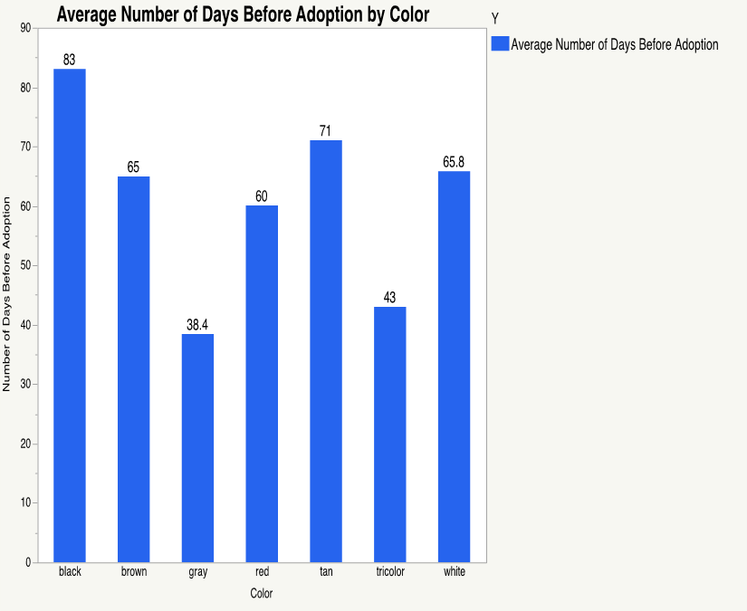 Carah Gilmore entered her school's science fair competition and advanced to higher levels with her project analyzing data about pet adoptions. (Images courtesy of Ryan Gilmore)Here at JMP, we love pets. So we were thrilled to hear that a young scientist used our software to explore data about pet adoptions from local animal shelters. The project is adorably titled "Furever Friends."
Carah Gilmore entered her school's science fair competition and advanced to higher levels with her project analyzing data about pet adoptions. (Images courtesy of Ryan Gilmore)Here at JMP, we love pets. So we were thrilled to hear that a young scientist used our software to explore data about pet adoptions from local animal shelters. The project is adorably titled "Furever Friends."
How young is this scientist? She is 10 years old, and her name is Carah Gilmore. Her father, Ryan Gilmore, works at SAS as a Senior Application Developer.
Carah's school, Mills Park Elementary in Cary, NC, strongly recommended that students take part in science fair, so Carah chose a topic that would help a charity dear to her heart.
"My dad and I take pictures for an organization named Rescue Ur Forever Friend to help pets get adopted quicker. I was wondering how I could help, so I thought of this project – what factors determine how fast a dog gets adopted," the rising sixth-grader says.
To identify those factors, she needed some data. She was able to get data from Rescue Ur Forever Friend and Second Chance Pet Adoptions. Ryan says the final data table had around 1,400 rows and 12 columns.
Ryan had worked in technical support for JMP and therefore knew the software very well. That's why he decided to teach Carah how to use Graph Builder and Tabulate to perform her analysis.
But before starting on her analysis, Carah had to do a bit of data preparation.
"The data from both organizations was given as Excel files. Carah combined the data into a single Excel file, which was then imported into JMP. New columns were created to compute the length of stay and age of the animals. Other columns were also created to categorize the dogs based on color and breed," Ryan says.
 Carah had looked at adoption time by breed.
Carah had looked at adoption time by breed.
What Carah learned
Black Dog Syndrome is the idea that black dogs spend more time waiting for a new home than lighter-colored dogs. Carah aimed to test that hypothesis and see what else she could learn.
"My results showed that it took longer for black dogs to be adopted," Carah says.
 Carah's graph from her science fair project showing that black dogs take more days to get adopted than dogs of other colors.
Carah's graph from her science fair project showing that black dogs take more days to get adopted than dogs of other colors.
Blacks dogs took 83 days on average to be adopted, whereas brown dogs took an average of 65 days. Gray dogs fared the best, waiting only 38 days on average for a new home.
Carah also found that female dogs were more quickly adopted than male dogs. As might be expected, large dogs took more days to be adopted than medium or small dogs. But what's surprising is that extra-large dogs spent the fewest days in the shelter before adoption, when looking at size alone.
Competing at science fairs, and beyond
At her elementary school science fair in January, Carah placed third, which qualified her to compete at the regional science fair the following month. She placed in the top eight among more than 100 students there and competed at the state level in March. While she did not place in the state competition, she did learn a lot along the way and helped spread the word about pet adoption.
What was the best part of doing this project for Carah?
"Helping the organizations. Creating the formulas and graphs in JMP. Also, finding out how long it does take different dogs to get adopted," Carah says.
The science fairs are over for this year, but she hopes all who have seen her findings (including you, dear reader) will "try to adopt a rescue dog and take a look at the black dogs because they’re just like the other dogs.”
Bravo, Carah!